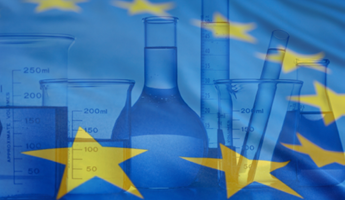Chemikalienstrategie für Nachhaltigkeit
-
Wissenschaftliche Themen in der Diskussion
- Krebs vorbeugen
- Chemikalien mit hautsensibilisierenden Eigenschaften
- Perfluoralkylchemikalien (PFAS)
- Mikroplastik
- Granulat und Mulche auf Sportplätzen
- Tätowierfarben und Permanent Make-up
- Glyphosat
- Stoffe mit endokrinschädigenden Eigenschaften
- Bisphenole
- Chemikalienstrategie für Nachhaltigkeit
- Tierversuche im Rahmen von REACH
- Phthalate
- Biocides
- Blei
- Research to enhance protection of our health and environment
Chemikalienstrategie für Nachhaltigkeit

Die Europäische Kommission hat am 14. Oktober 2020 ihre Chemikalienstrategie für Nachaltigkeit verabschiedet. Die Strategie ist Teil des Null-Schadstoff-Ziels der EU – eine zentrale Verpflichtung des europäischen Grünen Deals – und zielt darauf ab, die Bürgerinnen und Bürger sowie die Umwelt besser vor schädlichen Chemikalien zu schützen und Innovationen durch die Förderung der Verwendung sichererer und nachhaltigerer Chemikalien voranzutreiben.
Der europäische Grüne Deal ist die neue Wachstumsstrategie der EU. Sie wird Europa zu einer nachhaltigen und CO2-neutralen Wirtschaft machen und gleichzeitig auf die Wirtschaftskrise und die Folgen von COVID-19 reagieren.
Chemikalien sind die Bausteine der von uns genutzten Güter und für Hightech-Materialien, die für eine klimaneutrale Kreislaufwirtschaft benötigt werden. Die Herstellung von Chemikalien ist auch ein energie- und CO2-intensiver Industriezweig. Die Umstellung auf Chemikalien und Produktionstechnologien, die weniger Energie benötigen, wird zu einer Begrenzung der Emissionen führen. Das bedeutet, dass der Grüne Deal die „richtige“ Chemie benötigt.
Als spezialisierte Agentur der EU leistet die ECHA mit ihren wissenschaftlichen und regulatorischen Fachkenntnissen, Datenbanken, digitalen Instrumenten und Netzwerken sowie praktischen Erfahrungen mit der Chemikalienregulierung auf Anfrage einen Beitrag zur Strategie.
Die ECHA als EU-Organisation und Arbeitgeber verpflichtet sich im Rahmen des europäischen Grünen Deals, ihre Umweltzertifizierung auf das EU-System für das Umweltmanagement und die Umweltbetriebsprüfung (EMAS) auszuweiten und bis 2030 klimaneutral zu werden.
The Commission’s strategy provides an action plan to:
- Ban the most harmful chemicals in consumer products – allowing those chemicals only where their use is essential.
- Pay attention to the cocktail effect of chemicals when assessing chemical risks.
- Phase out per- and polyfluoroalkyl substances (PFAS) in the EU, unless their use is essential.
- Boost investment and innovative capacity for the production and use of chemicals that are safe and sustainable by design throughout their lifecycle.
- Promote the EU’s supply and sustainability of critical chemicals.
- Establish a simpler “one substance, one assessment” process for assessing the risks and hazards of chemicals.
- Play a leading role globally by championing and promoting high chemical safety standards and not exporting chemicals banned in the EU.
The Commission has asked ECHA to take an active role in the following work areas:
- Developing criteria for chemicals that are safe and sustainable by design.
- Assessing how to introduce mixture assessment factors in REACH.
- Establishing a “one substance, one assessment” process to coordinate hazard and risk assessment across chemicals legislation.
- Developing an indicator framework on chemicals as part of the Zero Pollution and 8th Environment Action Programme monitoring framework.
- Improving enforcement of chemicals legislation.
- Developing a strategic research and innovation agenda for chemicals.
- Developing EU-wide human and environmental biomonitoring in the context of the Partnership for the Assessment of Risk from Chemicals (PARC).
- Establishing an EU chemical early warning and action system.
In addition, ECHA will provide scientific and technical support for the impact assessment on planned revisions to REACH and CLP.
REACH revision
ECHA will support the amendment of REACH information requirements for substances that have critical hazard properties. The Agency is also involved in preparatory work for extending the registration duty to certain polymers, which currently do not need to be registered under REACH.
The Agency is a member in steering groups for studies and assessments on:
- information on volumes, uses, exposure/emissions and environmental footprint in REACH registrations;
- derived minimal effect levels (DMELs) for certain substances; and
- introducing a mixture assessment factor.
To improve the evaluation of chemicals, ECHA will provide information on the functioning of dossier and substance evaluation to the Commission with proposals to develop the two processes further.
To develop the use of the generic approach to risk management, ECHA will gather information on uses of certain hazardous substances. It will furthermore support the Commission in developing options to reform authorisation and restrictions. Additionally, the Agency will contribute to the development of criteria for essential uses of substances.
Until the generic approach to risk management is introduced and applicable in REACH, ECHA supports the development of criteria for prioritising substances and groups of substances for restrictions to establish a restrictions roadmap.
CLP revision
ECHA will assist the Commission in revising and developing new hazard criteria under the CLP Regulation for:
- persistent, mobile and toxic (PMT) and very persistent and very mobile substances (vPvM);
- terrestrial organisms;
- immunotoxicity and developmental neurotoxicity;
- endocrine disrupters; and
- persistent, bioaccumulative and toxic (PBT) and very persistent, very bioaccumulative substances (vPvB).
The Agency will assess the information it has available to identify substances that qualify for the new and further hazard classes or criteria and, where possible, set up a list of these substances.
European Commission
- Chemicals Strategy for Sustainability [PDF]
- Chemicals Strategy - background
- Chemicals Strategy implementation
- European Green Deal
- Commission's note to agencies on chemicals strategy 21 December 2020 [PDF]
- Commission's request to ECHA on chemicals strategy 12 April 2021 [PDF]
- Restrictions Roadmap
ECHA
- CLP Revision - ECHA input [PDF]
- ECHA's contributions to CSS work in 2023 [PDF]
- ECHA's contributions to CSS work in 2022 [PDF]
- ECHA's contributions to CSS work in 2021 [PDF]
- ECHA’s contribution to the Commission’s Restrictions Roadmap [PDF]
- ECHA news release 14 October 2020 - ECHA ready to help the EU achieve its ambitions for safe and sustainable chemicals


